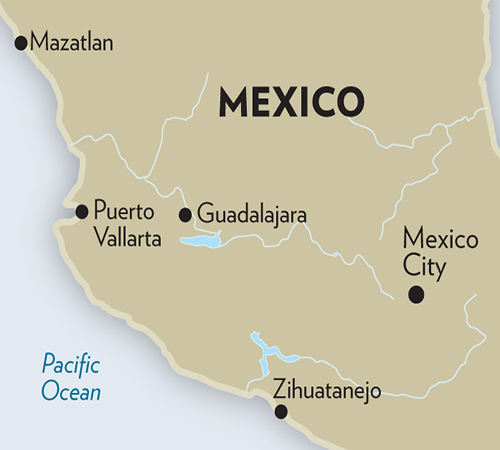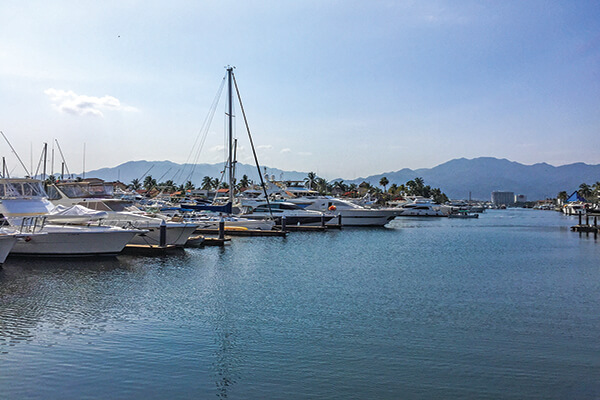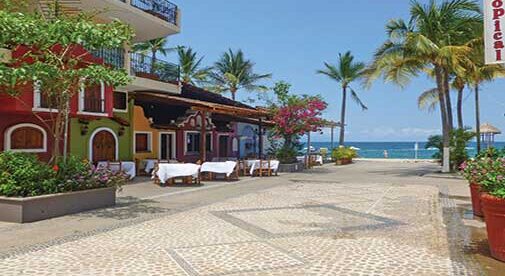The malecon was abuzz. Yachts, fishing boats, and catamarans traversed the Bay of Banderas. Along the seaside promenade, restaurants and bars set their tables right on the sand, unleashing an army of waiters to manage the flow of customers. The smell of international cuisine perfumed the air. There were bars and nightclubs you might see in Miami, boutiques, craft shops, and tequila tasting rooms.
This was the Puerto Vallarta I had come to expect. The place that’s been a hot favorite for millions of vacations each year. The place I’ve been returning to since I first visited on a scouting trip in 2012.
Back then, I came with a group of real estate investors. We were in the backwash of various global crises and I was watching for deals. The swine flu scare had dramatically cut visitors. The financial crisis was impacting banking and real estate markets. And the sluggish economy in North America was also slowing tourism, the lifeblood of the region.
At the tail end of Europe’s real estate boom, major Spanish banks had started to look for opportunities in places like Panama and Mexico—that was 2005 to 2008, when the Spanish market was clearly getting frothy. Some came here. But then it all went bust, and there were a number of condo buildings that had gone into foreclosure, controlled by banks eager to offload the properties. Condo units were going for $70,000 to $120,000.
Although I didn’t think it was the right time to invest then, I’ve been keeping an eye on Puerto Vallarta ever since, tracking its continued transformation and sniffing for deals and a new buying moment.
Recently, I’ve been taking a closer look at the town’s key neighborhoods, as well as the luxury enclave of Punta Mita and the vast collection of residential resort developments and gated communities known collectively as Nuevo Vallarta, built around golf and the beach.
Even since 2012, the market here has matured. You need to work harder to uncover deals. But new crisis moments like this create small windows: renewed opportunities to enter a strong rental market at prices that are rarely seen here anymore. Find the right motivated seller and you can do well.
Puerto Vallarta’s star has been rising steadily since 1963. That’s the year the steamy thriller The Night of the Iguana was filmed in Mismaloya, just to the south. Star Richard Burton carried on an affair with Elizabeth Taylor while filming; they made Puerto Vallarta their playground. The international tabloid attention caught the eye of travelers from around the world. What had once been a small fishing village and shipping port, discovered maybe by a handful of international and Mexican artists, was set on course to become the famous resort destination it is today. All thanks to Hollywood’s original power couple.
Burton and Taylor didn’t carry it alone. Puerto Vallarta was once only accessible by boat, small plane, or mule train, but the Mexican government, sensing the opportunity, put in a paved highway and built an international airport. More American attention came when President Nixon visited in 1970 for treaty negotiations.
The rest of the heavy lifting was done by its pristine white-sand beaches and sparkling aquamarine waters.
Now, the all-inclusives are here, from Marriott to Rui to Westin to Hilton. There’s a whole strip of them on the beach north of Puerto Vallarta proper, and more within the massive residential resort development of Nuevo Vallarta. Cruise ships stopped here every day of the week before the pandemic.
Then there is the town itself. The foothills of the Sierra Madre Mountains rise steeply from the water in up-and-coming neighborhoods like 5 de Diciembre. And every place has a view. Over in the Zona Romantica, also known as Old Town, it’s flatter. Sleek new construction is going up next to low-slung condo buildings that have been there for decades.

To the north of town is the start of the Riviera Nayarit, which runs 200 miles up the coast to San Blas and encompasses smaller beach towns like Bucerias, the funky seaside villages of Sayulita and San Pancho, and the ritzy enclave of Punta Mita—home to the likes of the Four Seasons and St. Regis luxury resorts, and multi-million-dollar villas.
Punta Mita is a place I took a closer look at on my last visit, as well as some of the more central neighborhoods in the town itself, like Versalles.
I personally enjoy the city. There are seven golf courses, I’ve played on most of them. The majestic Sierra Madre mountains, dotted with condos and luxury villas, are the backdrop to a string of golden-sand beaches buzzing with activity. It’s an appealing place. And it’s an appeal reflected in the numbers. Puerto Vallarta saw 5 million visitors in 2019, an 11% jump from two years previously.
Deals like those I found back in 2012 haven’t been available for some time. The market has long returned to its normal, mature trajectory. A good indicator of that are those same bank-owned condos. Like I say, in 2012 they were going for $70,000 to $120,000 each. When I last visited, I saw those condos listing for $300,000 to $500,000. The excess inventory that had built up ahead of the 2008/09 financial crisis has been absorbed.
There have been a few sparks of opportunity since. For instance, in September 2014, I found a deal on a new luxury condo in a quiet residential community, with a restaurant, café, and shopping plaza on site. The condo had been kept by the developer’s wife, and she was ready to sell for $79,000. Identical units were selling at the time for $139,000 after delivery. So, there was an easy 43% discount. On top of that, I reckoned that the unit could bring in $1,000 a month as a long-term rental. You’d be looking at a gross yield of 15%.
The current crisis has refocused my attention on rental appeal. Puerto Vallarta already had a strong rental market, but I only see it growing when travel bounces back to full capacity.
Local tourism officials have been very active in courting airlines, tour companies, and international travelers, and we’re set to see a strong recovery in demand from the North American market. And, although tourism dropped significantly in 2020, Mexico never really closed. Demand is set to explode once travel capacity rebounds.
This is one of the most successful expat communities in all of Mexico, in particular for snowbirds—Canadians especially flock here to escape the chilly north. There are said to be 50,000 or so part-time or full-time expats. Puerto Vallarta is a beach city where expats can while away those winter months in lush green hills and on sandy beaches. There’s no shortage of restaurants, nightlife, or fun activities. Big box stores, gourmet and specialty shops; North American-style gated communities; well-appointed condos, often with ocean views, all in the heart of the action. This is a place that has it all for the expats, part-time visitors, and tourists.
A friend made over $10,00o a month renting her condo.
National tourism will also be increasing. Expedia’s Annual Travel Trends Report for 2021 reports that Mexican tourists put Puerto Vallarta in the top three places they’ll vacation this year. They’ll come for summer vacations and week-long trips over Christmas and during Semana Santa…the place will be packed.
Additionally, European travelers can take long vacations thanks to great employment benefits, and they come with the whole family, so they need a condo. They love Puerto Vallarta for the sunshine, the sea, and its sophisticated feel.

Rentals for a nice home run about $1,500 a month, with strong demand for short-term rentals from vacationers and snowbirds. There’s also demand for longterm rentals from full-time expats as well as local managers and executives.
Then there’s the impending “Zoom Boom.” Puerto Vallarta has long been popular with the work-from-home crowd.
Good internet, fun things to do in the off hours, easy access from the U.S., great weather (it averages from 73 to 83 F year round)… the beaches. Those pioneering digital nomads will be joined by the thousands whose jobs are now online.
According to a Stanford study, 42% of American employees now work from home. Many won’t ever be going back to the office. And many are realizing there’s no need to stay in the U.S.
They’re taking their home office to hotspots like Tulum and Playa del Carmen on the Riviera Maya, Puerto Escondido further south in Oaxaca State, and I expect them to make Puerto Vallarta part of the Zoom Boom Trail.
Some will stay for a few weeks, others a few months. All need a place to rent. And they’re ready to pay $2,000 per month to live and work comfortably.
Back in 2019, a friend of mine made well over $10,000 a month by renting her luxury condo in high season, which runs four months from the end of November. She was able to achieve 80% occupancy, charging $500 to $700 a night.
There is a strong demand at this high end of the market, but it was seasonal. In the post-pandemic world, I expect rentals to depend less on seasonal traffic, as longterm travel becomes a viable option for millions of people.
Like I say, the market has matured in Puerto Vallarta. It’s an internationalized destination with a strong mix of renters. This limits our entry points. But I’m on the lookout for motivated sellers. And right now, I’m working at bringing a deal to members of my Real Estate Trend Alert group. By using our group buying power, we can negotiate excellent deals on best-in-class real estate, with discounts of $40,000 or more.
 Ronan McMahon is the editor of Real Estate Trend Alert and a contributing editor to IL. He spends at least six months a year crossing the globe in search of the best real estate deals worldwide. You can follow his adventures and advice by signing up to his free e-letter, Your Overseas Dream Home at: IntLiving.com/retmag.
Ronan McMahon is the editor of Real Estate Trend Alert and a contributing editor to IL. He spends at least six months a year crossing the globe in search of the best real estate deals worldwide. You can follow his adventures and advice by signing up to his free e-letter, Your Overseas Dream Home at: IntLiving.com/retmag.


